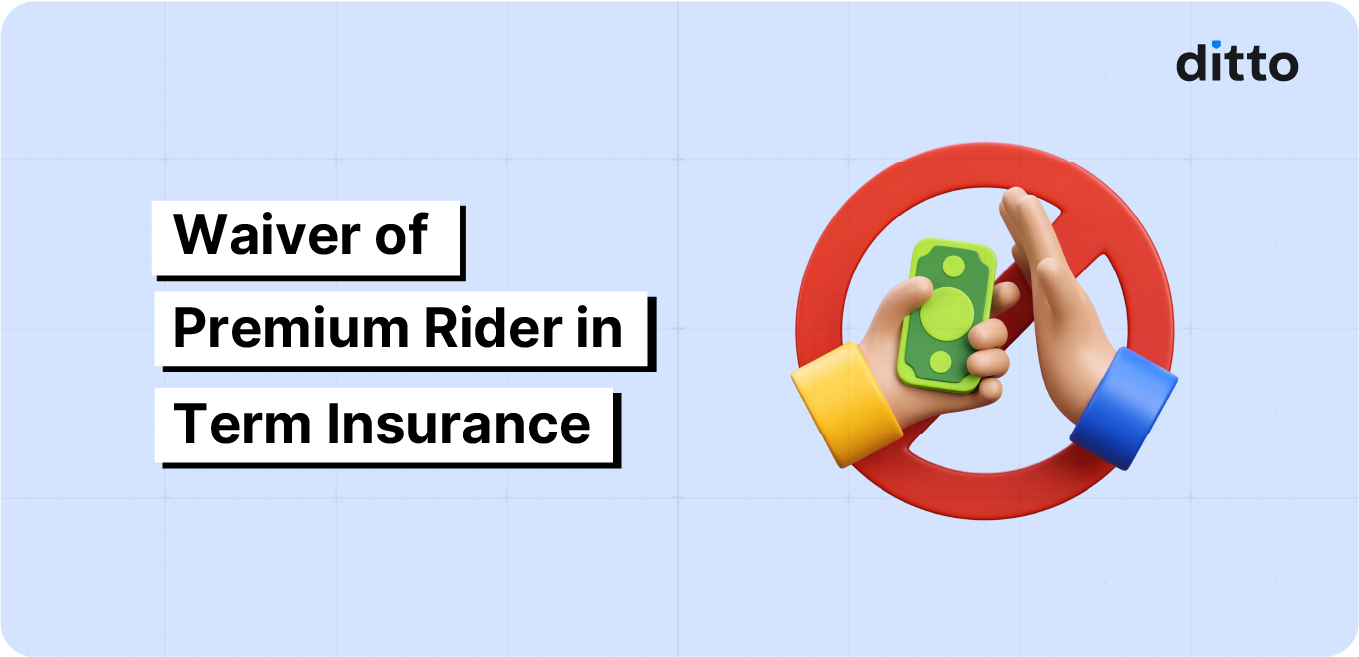What is the Waiver of Premium Rider?
Term insurance is meant to be your family’s safety net when life throws a curveball. But what if you fall seriously ill or suffer a disability that affects your income? In moments like these, even paying your policy premiums can feel overwhelming, and missing them could put your entire life cover at risk.
That’s exactly why the waiver of premium (WOP) rider exists. In this blog, we’ll break down how the WOP rider works, which plans offer it, key features, claim requirements, documents needed, and whether it’s truly worth adding to your term plan.

Popular Term Plans with the Waiver of Premium Rider
HDFC Life Click 2 Protect Supreme
This plan offers the most comprehensive waiver of premium rider, covering 60 illnesses, including disabilities, for the entire policy term.
Bajaj Allianz Life eTouch II
It provides a free in-built waiver of premium benefit that automatically waives premiums on Accidental Total and Permanent Disability (ATPD), and also includes coverage for terminal illness.
Axis Max Life Smart Term Plan Plus
This plan offers a waiver of premium rider on 11 critical illnesses and 4 disabilities, but only if the premium payment term is 15 years or less. It only waives premiums up to a maximum of ₹25 lakhs worth of premiums.
TATA AIA Sampoorna Raksha Promise and Maha Raksha Supreme Select
These plans offer a waiver of premium rider on 40 critical illnesses, along with coverage for Accidental Total and Permanent Disability, for dual protection.
Aditya Birla Sun Life Super Term Plan
It offers a waiver of premium benefit only on ATPD. For a 25-year-old seeking ₹1 crore coverage till age 65, the total yearly premium is ₹10,577.73, and ₹477.73 accounts for the WOP rider cost.
Key Features of the Waiver of Premium Rider
- Once the claim is approved, all future premiums are waived while your life cover continues normally.
- Medical emergencies often come with reduced income. Missing premium payments can cause policy lapse; this rider prevents that.
- Depending on the insurer, the rider may cover anywhere from 11 to 60 critical illnesses and accidental disabilities.
- Some plans (like Bajaj eTouch II) offer it in-built; others allow you to add it at purchase.
- WOP premiums are usually low compared to the base plan, often between ₹50 and ₹300 per month.
Note: The cost of the WOP rider depends on your premium payment term (PPT), not just the policy term. With regular pay, the insurer may need to waive premiums for 30–40 years, so the rider becomes more expensive. In limited-pay options (like 5-pay or 10-pay), the risk window is much shorter. Once premiums are fully paid, there’s nothing left to waive, so the WOP rider costs significantly less.
Waiver of Premium Claim Requirements
For the WOP rider to apply, insurers typically require the following conditions to be satisfied:
- Diagnosis of a listed critical illness, or
- Accidental total and permanent disability, or
- In some plans, a terminal illness diagnosis
- Completion of the survival period (usually 14–30 days)
- Rider must be active and the policyholder must have completed the waiting-period conditions (30 days - 6 months)
- The policyholder submits the correct documents. We’ve also included a section below on what these documents are.
Quick Note: Loss of income is not a trigger for the Waiver of Premium rider in term insurance.
How Does the Waiver of Premium Rider Work?
- You buy a term plan and add the waiver of premium rider (or opt for a plan where it is in-built).
- Continue paying premiums normally.
- If you’re diagnosed with a covered critical illness or suffer an accidental disability:
- Inform the insurer
- Submit medical documents
- Complete survival/waiting period conditions
- Once approved, the insurer waives all future premiums until the end of the policy term and gives you a written confirmation stating the same.
- Your life cover remains intact, so your nominee still gets the full sum assured in case of death.
Most importantly, the rider does not pay you money, it simply removes your obligation to pay premiums.
Documents Required for Waiver of Premium Rider Claim Settlement
- Rider-specific claim form
- Critical illness diagnosis report/disability certificate
- Treating doctor’s certificate
- Hospitalization records
- KYC documents of the life assured
- Policy document / e-policy copy
- FIR or accident reports (for disability cases)
- An independent, second medical confirmation may be required.
Why Choose Ditto for Term Insurance
At Ditto, we’ve assisted over 8,00,000 customers with choosing the right insurance policy. Why customers like Vijay below love us:

- No-Spam & No Salesmen
- Rated 4.9/5 on Google Reviews by 15,000+ happy customers
- Backed by Zerodha
- Dedicated Claim Support Team
- 100% Free Consultation
Confused about the right term insurance? Speak to Ditto’s certified advisors for free, unbiased guidance. Book your call now, slots fill up fast!
Conclusion
A waiver of premium rider is one of the most cost-effective protections you can add to your term insurance plan. At Ditto, we consider it to be a must-have rider for anyone buying term insurance. A critical illness rider comes second, but both should be chosen after carefully reviewing the claim terms, eligibility conditions, age limits, and your health profile.
For most people, especially sole earners, a waiver of premium rider is absolutely worth adding to your policy.
Frequently Asked Questions
Last updated on:









